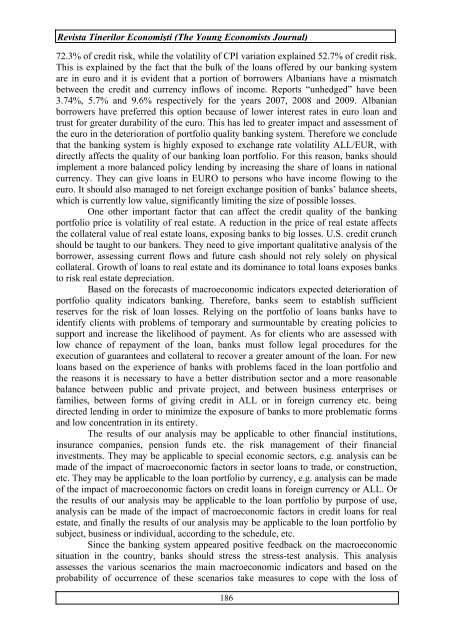Revista Tinerilor Economiºti (The Young Economists Journal)
Revista Tinerilor Economiºti (The Young Economists Journal)
Revista Tinerilor Economiºti (The Young Economists Journal)
Create successful ePaper yourself
Turn your PDF publications into a flip-book with our unique Google optimized e-Paper software.
<strong>Revista</strong> <strong>Tinerilor</strong> Economişti (<strong>The</strong> <strong>Young</strong> <strong>Economists</strong> <strong>Journal</strong>)<br />
72.3% of credit risk, while the volatility of CPI variation explained 52.7% of credit risk.<br />
This is explained by the fact that the bulk of the loans offered by our banking system<br />
are in euro and it is evident that a portion of borrowers Albanians have a mismatch<br />
between the credit and currency inflows of income. Reports “unhedged” have been<br />
3.74%, 5.7% and 9.6% respectively for the years 2007, 2008 and 2009. Albanian<br />
borrowers have preferred this option because of lower interest rates in euro loan and<br />
trust for greater durability of the euro. This has led to greater impact and assessment of<br />
the euro in the deterioration of portfolio quality banking system. <strong>The</strong>refore we conclude<br />
that the banking system is highly exposed to exchange rate volatility ALL/EUR, with<br />
directly affects the quality of our banking loan portfolio. For this reason, banks should<br />
implement a more balanced policy lending by increasing the share of loans in national<br />
currency. <strong>The</strong>y can give loans in EURO to persons who have income flowing to the<br />
euro. It should also managed to net foreign exchange position of banks’ balance sheets,<br />
which is currently low value, significantly limiting the size of possible losses.<br />
One other important factor that can affect the credit quality of the banking<br />
portfolio price is volatility of real estate. A reduction in the price of real estate affects<br />
the collateral value of real estate loans, exposing banks to big losses. U.S. credit crunch<br />
should be taught to our bankers. <strong>The</strong>y need to give important qualitative analysis of the<br />
borrower, assessing current flows and future cash should not rely solely on physical<br />
collateral. Growth of loans to real estate and its dominance to total loans exposes banks<br />
to risk real estate depreciation.<br />
Based on the forecasts of macroeconomic indicators expected deterioration of<br />
portfolio quality indicators banking. <strong>The</strong>refore, banks seem to establish sufficient<br />
reserves for the risk of loan losses. Relying on the portfolio of loans banks have to<br />
identify clients with problems of temporary and surmountable by creating policies to<br />
support and increase the likelihood of payment. As for clients who are assessed with<br />
low chance of repayment of the loan, banks must follow legal procedures for the<br />
execution of guarantees and collateral to recover a greater amount of the loan. For new<br />
loans based on the experience of banks with problems faced in the loan portfolio and<br />
the reasons it is necessary to have a better distribution sector and a more reasonable<br />
balance between public and private project, and between business enterprises or<br />
families, between forms of giving credit in ALL or in foreign currency etc. being<br />
directed lending in order to minimize the exposure of banks to more problematic forms<br />
and low concentration in its entirety.<br />
<strong>The</strong> results of our analysis may be applicable to other financial institutions,<br />
insurance companies, pension funds etc. the risk management of their financial<br />
investments. <strong>The</strong>y may be applicable to special economic sectors, e.g. analysis can be<br />
made of the impact of macroeconomic factors in sector loans to trade, or construction,<br />
etc. <strong>The</strong>y may be applicable to the loan portfolio by currency, e.g. analysis can be made<br />
of the impact of macroeconomic factors on credit loans in foreign currency or ALL. Or<br />
the results of our analysis may be applicable to the loan portfolio by purpose of use,<br />
analysis can be made of the impact of macroeconomic factors in credit loans for real<br />
estate, and finally the results of our analysis may be applicable to the loan portfolio by<br />
subject, business or individual, according to the schedule, etc.<br />
Since the banking system appeared positive feedback on the macroeconomic<br />
situation in the country, banks should stress the stress-test analysis. This analysis<br />
assesses the various scenarios the main macroeconomic indicators and based on the<br />
probability of occurrence of these scenarios take measures to cope with the loss of<br />
186















